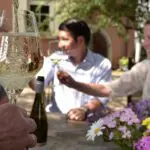[disclaimer: BottleStops was given a set of wineglasses by Zaltify. However, the text and opinions represent BottleStops’ own opinion only.]

What’s a wine glass? The common denominator for all glasses is molten Quarzsand – Siliziumdioxide for base material. But then it’s getting complicated. Impurities can and additives will define its transparency, its color, its weight, flexibility, and stability. And then of course there is the shape of the finished product… To us wine weirdos possibly one of the most important factors. Besides price that is.
Generally, there is a common agreement that a wine glass should be transparent, have a foot to stand on anchoring a stem that holds a bowl on top – and the bowl narrows towards the rim. That common agreement is fixed with the ISO International Standards Organisation standard for wine tasting glasses, by now accepted amongst many wine related organisations such as for instance WSET. The standard pays respect to the overall accepted fact a wine smells and tastes differently from differently shaped glasses (try it out yourself: you can start with a mug, a water glass, and a wine glass; on the next level taste the same wine out of a champagne flute, a martini glass, and then a wine glass).
But what’s THE best wine glass? And for which wine? Look back 20 years and it was Austrian wine company Riedel claiming to have all the answers – at some point in even looked like every single wine varietal would get its own glass. Ask the same question today in Hauptsache Wein, one of the most active and discussion-happy German wine groups online, and things can get quite messy with as many opinions as there are brands and shapes of wine glasses. It is still mostly about Austrian make, but people seem to be quite happy with one or two shapes per brand… as ‘universal’ as possible for red and white each. Brandwise it is handcrafted and mouthblown Zalto glasses just leading the pack, closely followed by Sophienwald. But then Germany’s Schott, Stölzle, or Swiss made Gabriel get more than just honorable mentions.
Whether you rank your options by price, by optics, by haptic and of course by the way they render your wine on the nose and palate… the truth seems to be settled very much in personal preferences and wallet size. In 2018 the blog Vinositas gave a shot at a systematic tasting and rating, with 6 wine nerds working 4 wines out of 10 high-end glasses – yet the outcome was indecisive at best. Half a year earlier NYT wine critic Eric Asimov had come to a similar conclusion… that with a certain set of features (back to foot, stem, tulip shaped bowl) many wine glasses were pretty good.
So how about us, at BottleStops? For our wine tastings and tours, we like Stölzle glasses – for their clean shape, clarity and affordability. Given our German wine and wine culture focus it is a matter of authenticity to use use glasses from a time-honoured traditional German brand. Privately though we tend towards light, elegant shapes, with very thin stems and rims. To our delight the Zalto glasses we got recently offered by Zaltify fit exactly that profile (Both the Burgundy and the Universal are so light, that the wrapping paper felt almost empty when pulling the glasses out of their boxes). And with that mindset, our favourite Rieslings and Pinots do taste better out of Zalto. To us these will be the best wine glasses in the world for quite a while. Thanks Zalto.








